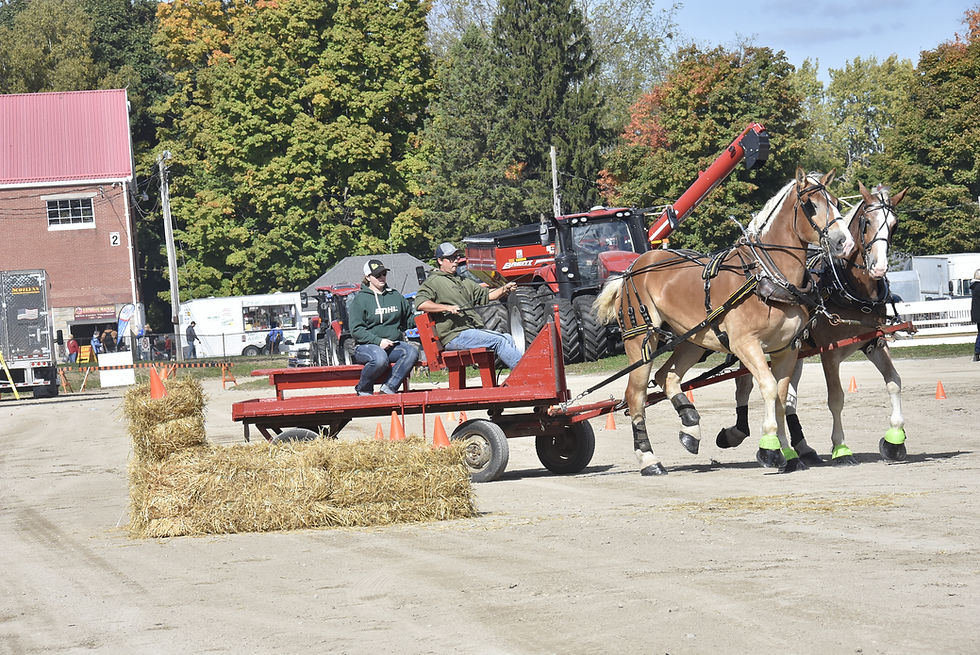Canadian government ‘takes the threat of avian influenza very seriously’
- Tamara Botting
- Oct 8
- 4 min read

By Tamara Botting
Highly pathogenic avian influenza (HPAI) is a serious threat, which is why the Canadian government puts a lot of effort into preventing it from spreading when it’s detected.
The disease was first detected in Canada in 2004, at a commercial chicken breeder farm in British Columbia. HPAI was first detected in Ontario 18 years later, in March 2022. That year, there were 43 infected premises in the province.
“Since the initial year of the outbreak, the number of infected premises dropped significantly in Ontario and has continued to remain low,” said Geneviève Trottier, Incident Commander with the National Emergency Operations Centre for HPAI with the Canadian Food Inspection Agency (CFIA).
In 2023, there were five infected premises in Ontario, and in 2024, there were seven. So far this year, there have been six; in mid-September, Trottier said, “there are no current infected premises in Ontario.”
The latest information on avian influenza detections, including the estimated number of birds in flocks impacted by province, is on the CFIA’s website, https://inspection.canada.ca/.
“The Government of Canada takes the threat of avian influenza very seriously and is putting a lot of effort into stopping it from spreading in Canada,” Trottier said. “When avian influenza is detected in domestic poultry, the CFIA implements strict movement controls and containment measures.”
In Canada, there is a requirement to report cases of avian influenza to the CFIA.
The Canadian government follows the internationally recognized standard ‘stamping out,’ for responding to avian influenza in domestic poultry, as defined by the World Organisation for Animal Health (WOAH).
The steps for the stamping out approach include:
1. Depopulation of the animals that are infected, suspected to be infected, or exposed to avian influenza
2. Disposal of carcasses and associated animal products, such as manure, in a manner to prevent the transmission of the avian influenza virus
3. Cleaning and disinfecting of the premises
Trottier said the CFIA and other agencies coordinate these responses, and that stamping out “is a primary tool to manage the spread of avian influenza and mitigate risks to animal and human health as well as enable international trade.”
Furthermore, Trottier said these efforts are “rooted in a One Health approach, recognizing the interconnectedness of people, animals and the environment.”
She explained, “The One Health approach aims to improve Canada’s capacity to adapt to the emerging risks through early detection, active prevention, and rapid response to avian influenza outbreaks.
“This surveillance strategy extends across wildlife, domestic poultry, dairy cattle, and humans, in close collaboration with federal and provincial governments, industry, academic and research institutions, Indigenous communities and international organizations such as WOAH.
“This ecosystem of partners forms an integrated network that allows Canada to detect threats early, act quickly and reduce risks to the economy, biodiversity and public health.”
One of the CFIA’s partner agencies is the Ontario Ministry of Agriculture, Food and Agribusiness (OMAFA).
As Connie Osborne in the communications branch for OMAFA and Ontario Public Service noted, “We continue to work with the CFIA and industry partners to monitor and respond to avian influenza. To help protect the agri-food sector from avian influenza, we have invested over $9 million to strengthen biosecurity, enhance testing capacity, and develop emergency preparedness resources.”
Osborne added, “Ongoing collaboration with federal agencies, other provinces and territories, and international partners ensures timely information sharing and alignment on best practices.”
Some of the most important partners in Canada’s efforts to monitor and control the spread of avian influenza are those on the front lines: the poultry and dairy producers, veterinarians, and industry associations.
As Trottier noted, these groups work together “to ensure proper biosecurity measures are in place and to facilitate rapid reporting and containment of any suspected cases. This includes sharing best practices for preventing the spread of the virus, as well as making sure that producers have access to the necessary tools and knowledge to safeguard their flocks/herds and their own health.”
She added that in striking the Avian Influenza Advisory Group, “the CFIA has solicited expertise from industry and the scientific and academic communities … Representatives help to ensure that CFIA policies and action plans are sound. These consultations are ongoing and continue to provide valuable intelligence that helps to shape the CFIA’s overall strategy to combat avian influenza in Canada.”
Of course, infected animals in the wild are not respecters of borders, meaning that Canada’s response to avian influenza can’t be insular.
That’s why Canada “is also involved in global efforts to monitor and control avian influenza,” through collaborations with international bodies like the World Health Organization (WHO), WOAH, and the Food and Agriculture Organization (FAO). These entities “share information and strategies for controlling outbreaks and preventing the spread of avian influenza,” Trottier said.
Ultimately, “Our disease response aims to protect both public and animal health, as well as minimize impacts on the $6.8 billion domestic poultry industry, and the Canadian economy.”




Comments